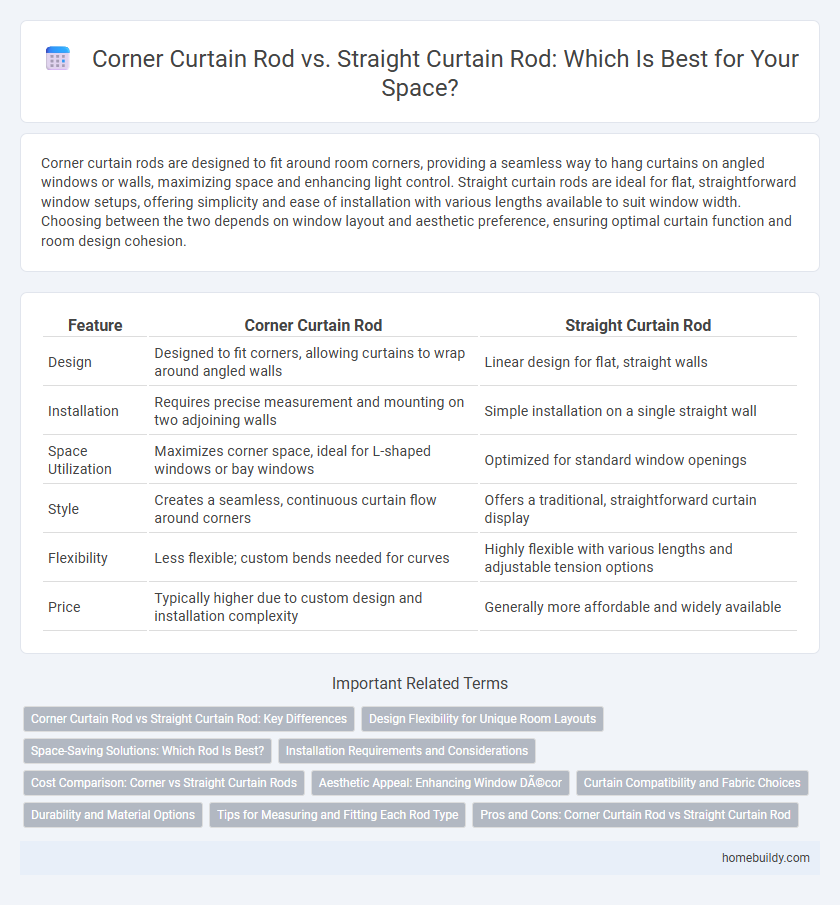Corner curtain rods are designed to fit around room corners, providing a seamless way to hang curtains on angled windows or walls, maximizing space and enhancing light control. Straight curtain rods are ideal for flat, straightforward window setups, offering simplicity and ease of installation with various lengths available to suit window width. Choosing between the two depends on window layout and aesthetic preference, ensuring optimal curtain function and room design cohesion.
Table of Comparison
| Feature | Corner Curtain Rod | Straight Curtain Rod |
|---|---|---|
| Design | Designed to fit corners, allowing curtains to wrap around angled walls | Linear design for flat, straight walls |
| Installation | Requires precise measurement and mounting on two adjoining walls | Simple installation on a single straight wall |
| Space Utilization | Maximizes corner space, ideal for L-shaped windows or bay windows | Optimized for standard window openings |
| Style | Creates a seamless, continuous curtain flow around corners | Offers a traditional, straightforward curtain display |
| Flexibility | Less flexible; custom bends needed for curves | Highly flexible with various lengths and adjustable tension options |
| Price | Typically higher due to custom design and installation complexity | Generally more affordable and widely available |
Corner Curtain Rod vs Straight Curtain Rod: Key Differences
Corner curtain rods are specifically designed to fit around angles or corners, enabling seamless window treatment in L-shaped or bay windows, while straight curtain rods are ideal for flat, single-plane window setups. The key differences lie in their shape, installation process, and adaptability to different window configurations, with corner rods providing enhanced flexibility for unique architectural designs. Material strength and mounting brackets vary between the two, impacting durability and ease of use in various home decor scenarios.
Design Flexibility for Unique Room Layouts
Corner curtain rods provide exceptional design flexibility by allowing curtains to elegantly wrap around angled walls and fit seamlessly into unique room layouts, maximizing window coverage and enhancing aesthetic appeal. Straight curtain rods offer a straightforward solution for standard window configurations but lack the adaptability needed for rooms with unconventional shapes or multiple wall angles. Choosing a corner curtain rod supports creative interior design by accommodating L-shaped windows and customized curtain arrangements that straight rods cannot efficiently handle.
Space-Saving Solutions: Which Rod Is Best?
Corner curtain rods maximize room efficiency by allowing curtains to wrap around walls, ideal for tight spaces and creating seamless window coverage in L-shaped or bay windows. Straight curtain rods are best for straightforward window treatments, offering a simple and cost-effective solution for standard rectangular windows. In terms of space-saving, corner rods optimize every inch by utilizing wall corners, making them superior in rooms where wall space is limited.
Installation Requirements and Considerations
Corner curtain rods require precise measurements and sturdy corner brackets to ensure proper alignment and support, often necessitating additional hardware for seamless 90-degree turns. Straight curtain rods demand straightforward wall mounts with uniform placement of brackets to support the rod's length evenly and prevent sagging. Both types require wall anchor compatibility depending on drywall or masonry surfaces to secure stability and prevent curtain rod loosening over time.
Cost Comparison: Corner vs Straight Curtain Rods
Corner curtain rods typically cost more than straight curtain rods due to their specialized design and the additional hardware required for installation. Straight curtain rods are generally more affordable, with prices varying based on material, length, and brand but usually lower compared to corner options. Budget-conscious consumers often choose straight rods for cost efficiency, while corner rods are preferred for accommodating window layouts that demand angled coverage despite the higher expense.
Aesthetic Appeal: Enhancing Window Décor
Corner curtain rods create a seamless flow around angled windows, adding architectural interest and maximizing natural light while maintaining a cohesive look. Straight curtain rods offer a clean, classic appearance that complements traditional window shapes and provides a versatile backdrop for various curtain styles. Choosing between corner and straight rods depends on window configuration and desired visual impact, enhancing overall window decor effectively.
Curtain Compatibility and Fabric Choices
Corner curtain rods provide greater compatibility with L-shaped or bay windows, allowing seamless drapery transitions around corners, ideal for heavier fabrics like velvet or blackout curtains that require sturdy support. Straight curtain rods suit traditional rectangular windows, supporting a wide range of fabric choices from lightweight sheers to medium-weight cotton, ensuring easy installation and versatility in design. Fabric weight and curtain style significantly influence rod selection, with corner rods better accommodating layered or pleated curtains due to their structural design.
Durability and Material Options
Corner curtain rods often feature sturdy materials like stainless steel or heavy-duty aluminum, designed to withstand stress at angled joints, enhancing durability in corners compared to straight rods. Straight curtain rods typically offer a wider range of material options, including lightweight metals and robust wood, providing versatile strength and style for linear window treatments. Both types prioritize durability but differ in material effectiveness based on structural demands and application.
Tips for Measuring and Fitting Each Rod Type
Measure the length and height of your window precisely to choose the correct curtain rod size, ensuring the corner rod accounts for the angled wall junction. For corner curtain rods, measure both wall segments and use a flexible tape to capture the bend accurately. Straight curtain rods require a straightforward width measurement across the window frame plus extra for curtain stack-back.
Pros and Cons: Corner Curtain Rod vs Straight Curtain Rod
Corner curtain rods maximize window coverage in L-shaped or bay window spaces, offering seamless curtain transitions around corners but may require custom sizing and more complex installation. Straight curtain rods are simpler to install, widely available in standard lengths, and ideal for flat-wall windows but lack flexibility for corner or uniquely shaped windows. Choosing between them depends on window architecture, desired aesthetic, and ease of maintenance.
Corner curtain rod vs Straight curtain rod Infographic

 homebuildy.com
homebuildy.com